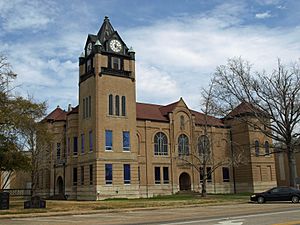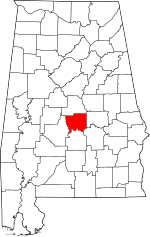Autauga County, Alabama facts for kids
Quick facts for kids
Autauga County
|
|
|---|---|

Autauga County Courthouse in Prattville
|
|

Location within the U.S. state of Alabama
|
|
 Alabama's location within the U.S. |
|
| Country | |
| State | |
| Founded | November 21, 1818 |
| Seat | Prattville |
| Largest city | Prattville |
| Area | |
| • Total | 604 sq mi (1,560 km2) |
| • Land | 594 sq mi (1,540 km2) |
| • Water | 10 sq mi (30 km2) 1.6% |
| Population
(2020)
|
|
| • Total | 58,805 |
| • Estimate
(2021)
|
59,095 |
| • Density | 97.36/sq mi (37.591/km2) |
| Time zone | UTC−6 (Central) |
| • Summer (DST) | UTC−5 (CDT) |
| Congressional district | 2nd |
|
|
Autauga County is a county located in the central portion of the U.S. state of Alabama. As of the 2020 census the population was 58,805. Its county seat is Prattville.
Autauga County is part of the Montgomery metropolitan area.
Contents
History
Autauga County was established on November 21, 1818, by an act of the Alabama Territorial Legislature (one year before Alabama was admitted as a State). As established, the county included present-day Autauga County, as well as Elmore County and Chilton County. At the time, Autauga (aka, Tawasa) Indians lived here, primarily in a village named Atagi (meaning "pure water") situated on the banks of a creek by the same name (called "Pearl Water Creek" by settlers). Autaugas were members of the Alibamu tribe. They sent many warriors to resist Andrew Jackson's invasion in the Creek War. This county was part of the territory ceded by the Creeks in the Treaty of Fort Jackson in 1814. The first county seat was at Jackson's Mill, but the court only met there long enough to select a permanent seat at Washington, built on the former site of Atagi in the southeast corner of the county. In 1830, the county seat was moved to a more central location at Kingston and the town of Washington dwindled until it was completely deserted in the late 1830s.
Daniel Pratt arrived in Autauga County in 1833 and founded the new town of Prattville, north of Atagi on the fall line of Autauga Creek. His cotton gin factory quickly became the largest manufacturer of gins in the world and the first major industry in Alabama. It was at his factory, and with his financial backing, that the Prattville Dragoons, a fighting unit for the Confederacy was organized in anticipation of the Civil War. Other units formed in Autauga County included the Autauga Rifles (Autaugaville), The John Steele Guards (western Autauga Co.) and the Varina Rifles (northern Autauga Co.). None of the fighting of the Civil War reached Autauga County, and Pratt was able to secure payment of debts from Northern accounts soon after the war, lessening the disabling effects of the Reconstruction period in the county.
Charles Atwood, a former slave belonging to Daniel Pratt, bought a house in the center of Prattville immediately after emancipation and was one of the founding investors in Pratt's South and North Railroad. The presence of such a prominent African-American family owning land in an Alabama city as early as the 1860s is exceptional.
In 1866 and 1868, Elmore and Chilton counties were split off from Autauga County, and the county seat was moved to the population center of Prattville, where a new courthouse was completed by local builder George L. Smith in 1870. In 1906, a new and larger courthouse was erected in a modified Richardsonian Romanesque style a block north of the older one. The building was designed by Bruce Architectural Co. of Birmingham and built by Dobson & Bynum of Montgomery.
Geography
According to the U.S. Census Bureau, the county has a total area of 604 square miles (1,560 km2), of which 594 square miles (1,540 km2) is land and 10 square miles (26 km2) (1.4%) is water.
Climate
The county has a prevailing humid subtropical climate dominated by its location in the Southern Plains ecological sub-region of the United States.
Major highways
 Interstate 65
Interstate 65 U.S. Highway 31
U.S. Highway 31 U.S. Highway 82
U.S. Highway 82 State Route 14
State Route 14 State Route 111
State Route 111 State Route 143
State Route 143
Adjacent counties
- Chilton County - north
- Elmore County - east
- Montgomery County - southeast
- Lowndes County - south
- Dallas County - west
Demographics
| Historical population | |||
|---|---|---|---|
| Census | Pop. | %± | |
| 1820 | 3,853 | — | |
| 1830 | 11,874 | 208.2% | |
| 1840 | 14,342 | 20.8% | |
| 1850 | 15,023 | 4.7% | |
| 1860 | 16,739 | 11.4% | |
| 1870 | 11,623 | −30.6% | |
| 1880 | 13,108 | 12.8% | |
| 1890 | 13,330 | 1.7% | |
| 1900 | 17,915 | 34.4% | |
| 1910 | 20,038 | 11.9% | |
| 1920 | 18,908 | −5.6% | |
| 1930 | 19,694 | 4.2% | |
| 1940 | 20,977 | 6.5% | |
| 1950 | 18,186 | −13.3% | |
| 1960 | 18,739 | 3.0% | |
| 1970 | 24,460 | 30.5% | |
| 1980 | 32,259 | 31.9% | |
| 1990 | 34,222 | 6.1% | |
| 2000 | 43,671 | 27.6% | |
| 2010 | 54,571 | 25.0% | |
| 2020 | 58,805 | 7.8% | |
| 2021 (est.) | 59,095 | 8.3% | |
| U.S. Decennial Census 1790–1960 1900–1990 1990–2000 2010–2020 |
|||
2020 census
| Race | Num. | Perc. |
|---|---|---|
| White (non-Hispanic) | 41,582 | 70.71% |
| Black or African American (non-Hispanic) | 11,352 | 19.3% |
| Native American | 184 | 0.31% |
| Asian | 873 | 1.48% |
| Pacific Islander | 22 | 0.04% |
| Other/Mixed | 2,675 | 4.55% |
| Hispanic or Latino | 2,117 | 3.6% |
As of the 2020 United States census, there were 58,805 people, 21,397 households, and 15,076 families residing in the county.
2010 census
As of the census of 2010, there were 54,571 people, 20,221 households, and 15,064 families residing in the county. The population density was 91 people per square mile (35/km2). There were 22,135 housing units at an average density of 36 per square mile (14/km2). The racial makeup of the county was 78.5% White, 17.7% Black or African American, 0.4% Native American, 0.9% Asian, 0.1% Pacific Islander, and 1.6% from two or more races. 2.4% of the population were Hispanic or Latino of any race.
There were 20,221 households, out of which 34.9% had children under the age of 18 living with them, 56.2% were married couples living together, 13.7% had a female householder with no husband present, and 25.5% were non-families. 22.0% of all households were made up of individuals, and 8.0% had someone living alone who was 65 years of age or older. The average household size was 2.68, and the average family size was 3.13.
In the county, the population was spread out, with 26.8% under the age of 18, 8.5% from 18 to 24, 27% from 25 to 44, 25.7% from 45 to 64, and 12.0% who were 65 years of age or older. The median age was 37 years. For every 100 females, there were 94.9 males.
The median income for a household in the county was $53,682, and the median income for a family was $66,349. Males had a median income of $49,743 versus $32,592 for females. The per capita income for the county was $24,571. About 8.3% of families and 12.1% of the population were below the poverty line, including 17.5% of those under age 18 and 7.0% of those age 65 or over.
In 2000, the largest denominational groups were Evangelical Protestants (with 18,893 adherents) and Mainline Protestants (with 3,657 adherents). The largest religious bodies were The Southern Baptist Convention (with 14,727 members) and The United Methodist Church (with 3,305 members).
Places of interest
Autauga County is home to several parks, such as Wilderness Park, Cooters Pond Park, Pratt Park, Swift Creek Park, Newton Park, Spinners Park, Heritage Park, and Overlook Memorial Park.
Communities
Cities
| Name | Area (sq. mi.) | Population | Population density (per sq. mi.) |
|---|---|---|---|
| Millbrook (partly in Elmore County) | 13.1 | 15,112 | 1,142.9 |
| Prattville (county seat; partly in Elmore County) | 33.8 | 35,229 | 1,033.6 |
Towns
| Name | Area (sq. mi.) | Population | Population density (per sq. mi.) |
|---|---|---|---|
| Autaugaville | 7.8 | 870 | 114.2 |
| Billingsley | 1.3 | 144 | 110 |
Census-designated places
| Name | Area (sq. mi.) | Population | Population density (per sq. mi.) |
|---|---|---|---|
| Marbury | 23.23 | 1,418 | 61 |
| Pine Level | 24.858 | 4,183 | 170 |
Unincorporated communities
Ghost town
In popular culture
- Autauga County is the main setting of Rita Williams-Garcia's novel Gone Crazy in Alabama.
Education
The Autauga County School System is the county's public school system.
East Memorial Christian Academy is located in an unincorporated area of the county, near Prattville.
Notable people
- Samuel Smith Harris, (1841-1888), born in Autauga County, Presbyterian clergyman, founder and editor of Living Word magazine, and bishop of the Diocese of Michigan.
- William Henry Lanier, (1855-1929), born in Autauga County, was a prominent educator who served as president of Alcorn A. and M. from 1899 to 1905. He also served as superintendent of Yazoo City and Jackson, Mississippi black schools.
- Wilson Pickett, (1941-2006), born in Prattville, Alabama, American recording artist best known for singing In the Midnight Hour and Mustang Sally.
See also
 In Spanish: Condado de Autauga para niños
In Spanish: Condado de Autauga para niños

